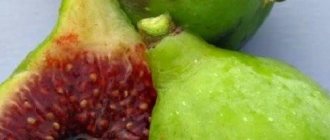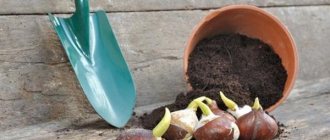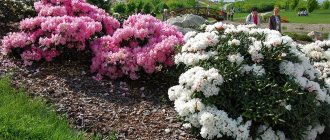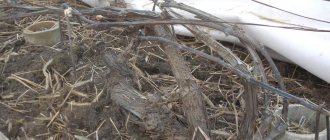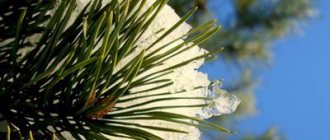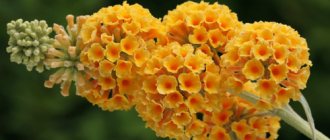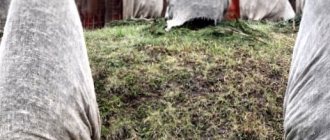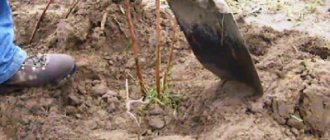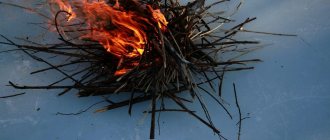Why does thuja need shelter?
Many gardeners wonder whether it is necessary to cover a tree in winter. It is believed that mature strong trees over 5 years old do not need special shelter. They tolerate northern winters well with temperatures down to -30°C, while young seedlings suffer from severe frosts. But both adults and young animals equally suffer from sunburn, heavy snow and strong winds.
The main dangers for thuja are:
- frosts without snow;
- heavy snowfalls;
- wet snow sticking to branches;
- bright sun reflected by a white cover.
Snow load on young trees leads to deformation and bending of branches, due to which the tree loses its natural crown shape. Under the snow cap, the shoots of a fragile tree become bent. To prevent this from happening, small thujas must be covered for the winter. Tying it with twine and building an improvised hut covered with special materials over the young seedlings will help protect the crown from sticky snow and sunburn.
When can thujas be prepared for wintering?
The timing of shelter is determined by the climate of the region where conifers are grown. But there is one rule: you cannot cover plants if the weather outside is still warm and the temperature is above zero. Otherwise, the trees will begin to overheat and get sick. Therefore, it is important to wait for a drop in temperature and slight frost, which most often comes after the first snow.
In the central zone, thujas are covered in the first ten days of November, in the north about a month earlier. This applies to the aboveground part of the plant. Regarding the root system, which also needs insulation, it can be mulched earlier. Compost or humus is suitable as mulch for the bottom layer and spruce branches for the top.
Correct timing
Coniferous trees receive severe burns at the end of February, when the sun's rays are reflected from the snow cover. To save the plant, it must be covered in time. This should be done in late autumn after leaf fall or in early winter during the thaw after the first snowfall. The procedure for covering thuja, depending on the region of growth, is carried out at different times.
Thuja shelter for the winter.
The optimal condition for creating protection is a stable air temperature from -5°C to -7°C. If early frost is not expected, then the recommendation for the main regions of Russia looks like this:
- in Siberia - late November - early December;
- in the Moscow region - December;
- in the middle zone - late December - early January;
- in the Urals - November.
Disinsection and pest protection
Fungal infections are the scourge of coniferous plants; they attack the plant both in early spring and autumn. In order to prevent the massive proliferation of infections, disinfestation should be carried out no later than a month before the thuja is supposed to be hidden for the winter, until the average daily air temperature drops below +12°C. Copper-containing preparations, such classical fungicides as:
- "Bordeaux liquid";
- "Abiga Peak".
Trees are treated with preparations according to the instructions on the packaging.
A change in the color of the needles - yellowing, blackening, drying out of individual branches - is a signal for a thorough examination of the thuja crown. There is a possibility of infection by false scale insects (or coccida). If you do not fight this dangerous pest, it will destroy the plant. The eggs of pseudoscale insect larvae are carried by the wind, causing infection of neighboring plants.
Therefore, when a pest is detected, nearby areas are also treated.
For prevention purposes, the crown is sprayed in early spring and mid-summer, when new offspring of false scale insects appear. In case of severe infection of needles, systemic drugs are used to control the pest, these include:
Insecticides:
- "Confidor";
- "Aktara";
- "Engio";
- "Anti-Khrushch."
Organophosphorus:
- "Aktellik";
- "Karbofos".
Spraying thuja.
The chemicals are diluted in accordance with the instructions, after which the area around the plant’s trunk is watered. Treatment is carried out 2 times per season with an interval of 14 days and alternating chemicals.
Features of proper planting
If you follow our tips and recommendations in detail, you will notice that self-planting and caring for the thuja Smaragd, the photo of which is presented below, is very simple. The most important thing you should do before boarding is:
- choose healthy, fresh seedlings;
- carefully select good cuttings;
- choose a place for the thuja (it is desirable that it grows freely).
Preparing for landing
First of all, decide how exactly you will plant thuja western Smaragd. There are 2 options here: either you purchase seedlings of a special type in plant nurseries, or you plant a tree using cuttings. The first method is the simplest, but quite expensive, but you will save a lot of time. The second option will cost you much less. For this you will need two-year-old thuja shoots. They should take root and then be ready to plant.
As for ready-made seedlings, which are usually sold in small bags, they should be carefully inspected before purchasing.
If the needles of the seedlings have a pale green appearance, then it is better to put them aside. Also note that the root system of the seedling must be fully developed and of medium size.
When choosing a place to plant thuja, consider the following points:
- A place in the open sun is not the best place for Thuja Smaragd. She may get burned due to constant lack of moisture.
- A place in the shade is also unfavorable for the plant, as it may die.
- The best place for planting is moderate partial shade. Try to choose an area protected from drafts and wind.
Tree planting process
Now that you have chosen a place for planting, good seedlings and cuttings, it’s time to start planting. You will grow a beautiful, healthy, long-lived tree if you consistently follow our advice:
- The best period for planting a tree is the end of May or the beginning of June. It is not recommended to plant trees in the fall; if early frosts hit, the seedlings may not take root and die.
- We talked about the fact that thuja takes root in any soil. But in order for the tree to grow healthy and fluffy, the soil must be prepared with a drainage system. The ideal option for drainage under thuja is drainage from a 15 cm layer of gravel or crushed brick.
- Dig a hole commensurate with the size of your seedling's root system. A depth of one meter will be quite sufficient.
- Don't forget to prepare a special mixture. To do this, thoroughly mix the following “ingredients”: turf soil, leafy soil, sand and peat (or peat deposits).
- You can accelerate the growth of thuja western Smaragd using manure or compost waste. Don't forget about mineral fertilizers too.
- Moisten the hole filled with soil thoroughly with water. Moisture is extremely necessary for a young tree.
- Plant a ready-made seedling or a created cutting in the prepared area along with a lump of earth from which they grow.
- Pay attention to the fact that the root collar of the seedling must be strictly located at ground level.
If you want to plant a hedge rather than a single plant, then make sure that the distance from one tree to another should be at least 50 cm, but no more than 1 m.
As you can see, planting thuja Smaragd is very simple. Now that you know how to plant thuja correctly. You can grow an entire hedge.
Covering methods
There are 4 main methods of covering coniferous trees:
- Construction of the frame.
- Circular strapping.
- Protective screens.
- Ready-made covers.
To properly cover thuja, it is advisable to familiarize yourself with the beneficial properties of covering materials. To protect against frost, use the following:
- Kraft paper is a cheap but unreliable option. Such material will become wet due to autumn rain, and if frost subsequently occurs, the paper will ice up and lose its heat capacity.
- Gauze is an inexpensive material, but it gets wet and is set by frost, just like paper.
- Burlap is an effective but cost-effective option if you need to cover a lot of trees. To allow the plant to breathe, choose thin burlap. You cannot use potato bags for shelter - the plant will suffocate in them.
- Facade mesh with a density of 42 g/sq.m. m. One of the best and economical options. The temperature underneath is the same as outside, and air circulation is ensured. The mesh creates shade but still allows in the sunlight needed for the tree to grow. Another plus is the durability of the material. Used on adult thujas.
- Spunbond is a cheap non-woven synthetic material. It can only be used for stretching on a frame, so that the leaves do not touch the covering fabric. Simply wrapping the crown of a tree with spunbond is unacceptable - it will suffocate from lack of oxygen. It is recommended to stretch a white fabric over the frame to reflect the sun's rays.
Gauze for covering thuja.
It is forbidden to use plastic film or cellophane for covering, since these materials do not allow air to pass through, and the plant under them will suffocate and rot.
Mulching the tree trunk circle
To prevent the roots from freezing and to maintain a supply of moisture in the root space, the tree trunk circle is mulched. Organic materials are traditionally used for this:
- straw;
- peat;
- needles;
- bark;
- cones;
- fallen leaves;
- humus.
Using organic mulch reduces the risk of weeds germinating. A protective layer of organic matter conserves water in the soil, maintains the microclimate around the root system, protecting it from winter cold and summer sun. The thickness of the mulch layer depends on the composition of the soil and the degree of freezing of the surface layer in a given region. A layer of up to 5 cm is considered optimal. On loamy soils it is reduced to 2 cm.
To avoid the occurrence of fungal diseases and rotting of plant roots, the mulch should not lie closely to the trunk or root collar. Before mulching, the soil is loosened and weeds are removed. The soil should be moist, but not wet. The disadvantages of mulching are the attractiveness of organic matter for overwintering pests and the spread of bacteria and fungal infections. To prevent these troubles, the organic layer is treated with microbiological preparations such as Fitosporin and Aktara.
Circular tree tying
Before covering the thuja, tie the crown in a circle using twine. The end of the twine is attached to the base of the trunk, after which the entire tree is carefully wrapped in a spiral. The side branches are carefully bent to the main trunk and tied in a circle from below to the crown.
Tying a thuja for the winter.
Upon reaching the top of the tree, the strapping is done in the opposite direction to the base and again fixed to the trunk. Next, wrap the thuja with covering material, which is also wrapped with twine, being careful not to overtighten.
Frame construction
Young trees require the construction of a frame for shelter. It is made from wooden blocks or metal fittings. To prevent the fittings from rusting, they are pre-painted. 3-4 rods are driven into the ground in the form of a pyramid, crossing their upper ends above the top of the tree. The frame is fastened with wire or metal tubes. After this, the structure is wrapped in 2-3 layers of breathable covering material. A gap of 10-15 cm from the ground is left below for air circulation. When snow falls, roots are sprinkled through this hole.
The frame method is the best for covering young seedlings. If everything is securely fastened, this design will withstand strong gusts of wind and heavy snowfalls.
Ready-made covers
Garden stores sell ready-made covers for covering trees from snow. This option should be used only as a last resort, if for some reason you do not have time to thoroughly prepare your garden plants for wintering.
Covers for covering thujas.
The covers are made of non-woven artificial materials, and under such cover the moisture evaporates with redoubled force, creating the effect of a microgreenhouse. The branches that come into contact with the fabric will suffer the most. Industrial covers can be used if they are stretched over the frame. There are ready-made kits for sale: case + frame. Here it is important to choose the right size so that the tree does not feel cramped in the winter house. When choosing a cover for a thuja in a store, it is better to give preference to covers made of white linen.
Sun protection screen
Sunburn is the most common problem that occurs with coniferous trees. This happens at the end of winter and spring, when bright sunlight reflected from the snow is especially aggressive. Spring burns occur as a result of moisture deficiency in the needles.
In young plants, the root system is not yet deep enough and poorly developed. In winter, the top layer of the earth freezes very much, and the plant cannot replenish its water supply from the soil, so moisture evaporates from the branches and needles, which leads to desiccation and death of individual parts of the plant. Most often, the open part of the crown, located on the sunny side, suffers.
The most effective method for protecting conifers from ultraviolet burns is to install a protective screen in front of the crown. To do this, several poles are driven in on the south side, onto which the sun protection material is stretched. To prevent the crown from being crushed, you should not install the screen close to the tree. After the snow melts, the screen is removed. This method will only protect trees from spring burning.
How to restore thuja after winter?
Not everyone carries out preparatory measures, so in the spring they may see a completely bleak picture. This may be a change in color, drying out (partial or complete) and falling of needles, curvature of shoots, and others. Most often people wonder why the thuja turned yellow after winter. There may be several reasons for this.
Firstly, thuja prefers light soils, slightly acidic or slightly alkaline. Therefore, make sure that the alkali content is low, which can be done using a special indicator test (available in garden stores).
If you have a dog, you should limit its access to thujas, as its urine can burn the needles and increase the alkali content in the soil. You can acidify the soil by adding peat or compost.
To revive the plant, you need to feed it, treat it with stimulants (2-3 times - one treatment per week) and sprinkle the crown at least once a week.
Secondly, the cause of yellowing and drying out may be a spring burn . It usually occurs when the air begins to warm up quickly, which stimulates the growth of shoots, but the soil cannot thaw so quickly and remains frozen, so the roots are still at rest.
Weakening the plant, in turn, can cause it to become sick and pests may appear. Therefore, it is necessary to shake off the dry pine needles with your hands, collect them and burn them. There is no need to prune; you will do this next spring, when you can see for sure which branches have dried up.
Then, every 2-3 weeks, treat the thuja along the crown with fungicides (for example, phytosporin) . Also spray with stimulating drugs (epin 3 times for 3 weeks) and irrigate the crown with plain water in the morning and evening. These measures will help the plant, but do not expect a quick recovery, it may take 2-3 years. This is exactly how long it may take to completely restore the needles.
Sometimes the cause of poor condition of thujas can be improper planting. Therefore, before you plant a plant, make sure that you do it correctly.

